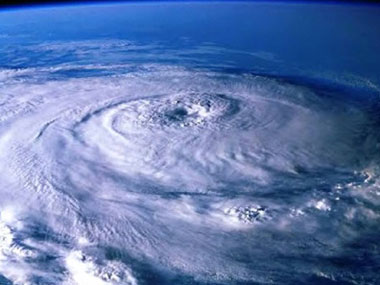DID A BITCH WIND BLOW ABORIGINAL ART ONTO THE WORLD STAGE?

Eye of a Cyclone (Source: AG's Emergency Management site, original photo source unknown)
Frannie Hopkirk | 14.09.14
Was Cyclone Tracy a freak accident of cosmology, an epic drama involving a vengeful wind, or just a pissed off tropical storm?
The insinuated anthropological terminology given to destructive natural disasters such as Tracy has 'Her' with the best of them. Calamities on this scale are often given female names. The terminology is sexist – and it is true, Tracy (like Katrina and others) did act like a black-hearted woman, spewing spite, wiping out a city, uprooting thousands of lives, property and killing people. Far from a spectacular meteorological event – Tracy qualifies as, The Perfect Storm. And it happened here.
It is the human aspect of these events that embues them with mystery and unbearable sadness. Not only is it the toll of people and cultures, but it is the strange ‘abstract’ nature of the wind and its behaviour - its odd sense of entitlement. The Tracy story is eternal, it will never end. Like paintings on a cave wall, Tracy is one storm engraved on the Australian psyche.
It is 40-years this year since Tracy turned its biblical fury on the small, cosy city of Darwin - a fragile, tropical, cosmopolitan, Somerset Maugham-prototype. Once described as an, ‘unsophisticated fibro city’, it is close enough to Asia for the proverbial cuisine of the Australian barbeque and Indonesian satay to sit happily on the same menu. Darwin was, and is, Australia’s farthest outpost and as the capital of Northern Territory, it’s our smallest capital city. Christmas Day 1974 was Darwin’s 9/11.
Tracy began her story and her journey above the frozen Steppes of Siberia. As the Devil’s Spawn she set forth without plan or identity. Packing a malcontented energy, she headed slowly south. Six-months later she found herself in a warm, benign place – the Tropics. Conceived in severe cold, this lazy Creature had attitude from the beginning.
Warm water suited her restless sensuality: she frolicked in the Timor Sea; she danced into the Arafura Sea. And like a tourist looking for trouble on a holiday, she tooled around, young, carefree, still without a name, unimpeded by her as yet to be determined fate - the clouds her streaming hair, her great vain ‘eye’ opening and closing, expanding and contracting.
Unexpectedly from a strong wind she morphed into a tropical cyclone - one of the most feared and destructive natural forces on earth. A very different Beast was born. She was now Tracy, something with authority, a presence inciting terror. Then, riding at 125km, as she stroked her hair and rolled her ‘eye’, her world and ours changed forever. She was already in the history books – yea – part of myth. “Here I come!” she shrieked as she clipped the Tiwi Islands, streamed and roiled into the waters off Darwin.
Rolling and boiling, whipping and twirling her long tresses, she reaches a fickle maturity over monsoonal lands, islands where heat rises to greet cold air – the dangerous marriage of hot and cold was consummated. The brat had come of age as a tropical storm.
Every aspect and detail of this event is riven with innuendo, paradox, contradiction: a human story born in nature, its unmistakable feminine aspect is grounded in the myths and legends of Mother Nature – the nurturing, all-loving female which can destroy. That this lazy yet determined wind born on ice, could make its way halfway across the world to the Tropics, appearing to meander, teasing with a drawn-out sense of menace, playing elaborate games, loitering with intent, holding back, secreting her power, all illustrate how mystical religious superstitions and belief systems can be drawn. Something natural was acting like a super spiteful-being, but it was only a wind.
Then at one crucial moment, as she was watched by teams of meteorologists and weather experts of all kinds, when it looked like she might have blown down the coast, causing havoc as she went but leaving Darwin alone - she didn’t. Strangely and fatefully she made a sudden right-hand turn, and headed straight for Darwin. Tracy had found her destiny.
Specialist speculation persists as to why the ‘eye’ changed direction, why there were changes in wind speed and why the trajectory moved so fecklessly, culminating in that last right-hand turn, from south-west to east?
This sudden development meant the ‘eye’ (no pun intended) was cast, and everyone knew it. Darwin was now directly in Tracy’s path. At the big mapping table where teams of experts were tracking the wind’s path, someone spoke into the silence with heart-stopping accuracy, “She’s a goer!”.
What are the metaphysical mysteries behind such a perfect act of destruction, a performance so flawless in its ultimate goal? Weirdly, with wind gusts now at 289kms she was still moving, as she had done throughout, at 6kms per hour. The anticipated and prayed-for wish that she would blow down the coast, slowly losing strength, was an irrational hope - one cannot reason with Mother Nature.
“She’s a Goer!” – those fatal words tolled Darwin’s End. Meantime, many of the town’s population were still doing last-minute Christmas shopping, arranging barbeques, opening tinnies, wrapping presents, expecting Santa.
But Tracy did not become a story until it was all over. Darwin experienced this hell, alone. The knowledge that nothing was ever going to be the same again was not yet available to them - that this wind was going to take it all. The shock reality as the first onslaught hit, followed by 20 minutes of deathly silence as the ‘eye’ passed, then the last, far more extreme savagery of the final phase – the slow unwinding of a nightmare. Individual stories of what happened to the brave souls who chose to stay and ride out that infernal night, those 12 hours of horror – beginning early evening with a hot, heavy strange drizzle, then continuous sheet lightning, the ceaseless screaming of the wind, the deafening calamitous noise of alarms, of houses, cars, boats, trees being blown away, sheets of corrugated iron hurling about like leaves. Finally, an hour before dawn, the loud moaning of an exhausted cyclone. The story makes for unbearable reading. One has to stop and remember to breathe.
But what is born of a catastrophe on this scale? “A disaster of the first magnitude”? (Bruce Stannard, The Age).
CHANGE!
Did Tracy represent a rebirth, a cleansing? The rituals and challenges of rebirth and cleansing are a powerful and meaningful aspect of any civilization grounded in order and a traditional life.
So, we begin again. What is left? Who is left? Who will begin the next story? Who will tell the world what happened? When the sandblasting of a culture is done, who is going to build the next one? The Aftermath is where the story begins again.
The sensation, after the noise stops and the wind has died, heavy with grief and promise, fear and elation, an urge to thank God for sparing them, their kids, their boat, their house, their animals. To look around and see the reality of what went down during those hours when families are traditionally opening presents or lighting the barbeque.
THE AFTERMATH
Something I read in Hetti Perkins' book, ART+SOUL*, about an incident involving Rover Thomas set me off on a chain of thinking about the deeper impact of Tracy on Aboriginal art and culture. Over many months the fragment of conversation between an old woman, who had been in a car accident at the time of the cyclone, and Thomas became almost an obsession with me.
I knew that many hundreds of the Aboriginal population of Darwin had become refugees along with Indians, Chinese, Americans and Australians, all of whom had experienced the same fate at the hands of the cyclone. Overnight the Stuart Highway had become a river of despair as disenfranchised, homeless and injured souls swarming the road south, most not knowing where their fate lay. All heading to the safety of Katherine.
Rover Thomas, soon to become one of the super stars of Aboriginal Art, had spent 40 years working on the Canning Stock Route and as a stockman in the Kimberley. He was already mature and had never picked up a paint brush when he received his Dream message from the dead woman. She spoke to him about the Rainbow Serpent that had caused the Cyclone and ‘Spirits on the loose' (my words); of the general upheaval, fear and confusion everywhere, and the loss of Aboriginal culture. The exchange was obtuse, non-specific, but to me it seemed loaded with meaning.
There was something about all those number 40s: Thomas had worked with stock for 40 years; it was 40 years since the Cyclone; Aboriginal Art had been part of secret rituals held from European eyes for 40 thousand years.
The notion of Aboriginal spirits being let loose by the Cyclone is credible. In an ancient culture rich with taboos, myths, legends, stories involving ancestors, and no shortage of subject matter, sacred or profane – shaking THAT world to its foundations was patently a big part of the Tracy legacy. It kick-started one of the most spectacular renaissances in the history of art.
Soon after Tracy, slowly but surely until it became a flood, the art started appearing openly, in galleries and in collections. The money started to flow. Dealers were driving to the Outback in four wheel drives like a walk in the park, coming back loaded with masterpieces. The rest is history.
Calculating the responsibility for disguising the Sacred nature of the works, of hiding their symbols, maps, ancient secrets - secrets which by lore could never, under pain of a spear or death, be revealed - was a skill soon developed by the artists. The very act of laying brush to canvas had to be approved by the Elders; often family members assisted in the creation of a painting. A subtle and mysterious form of abstraction was born, or had always been born.
The visual intelligence of these paintings is their magic. The double meaning inherent in the works, the genius of their appearance which we read as abstract, is key to its power and strangeness, making Aboriginal Art the sensational success it has achieved the world over.
PARIS TOKYO LONDON BERLIN NEW YORK - THE MAINSTREAM!
* See Patrick Mung Mung's chapter.
5* BOOK RECOMMENDATION
Gary McKay's A tribute to Tracy: The Storm That Wiped Out Darwin on Christmas Day 1974, Allen and Unwin (2001) was used in researching this piece. Frannie regards this as a wonderful book and a great read, which you can purchase from www.booktopia.com.au or at any good book store.
Share this:
»  del.icio.us
»
del.icio.us
»  Digg it
»
Digg it
»  reddit
»
reddit
»  Google
»
Google
»  StumbleUpon
»
StumbleUpon
»  Technorati
»
Technorati
»  Facebook
Facebook
Contact Details

Darwin in the aftermath of Cyclone Tracy (Photographer unknown)

Then Prime Minister Gough Whitlam MP (first white car) inspects the wrecked suburb of Casuarina after Cyclone Tracy hit Darwin (Photo: Bruce Howard)
Further Research
News Archive
- 11.10.17 | RETURN OF MUNGO MAN
- 10.10.17 | TARNANTHI 2017
- 11.08.17 | Natsiaas 2017
- 08.08.17 | ABORIGINAL ART ECONOMICS
- 02.08.17 | SCHOLL'S NEXT MOVE
- 20.07.17 | APY ART DOMINATES THE WYNNE
- 17.07.17 | Anangu Artist Wins $100,000 Prize
- 14.07.17 | The End of AAMU
- 13.07.17 | YOU ARE HERE
- 11.07.17 | ART ACROSS THE COUNTRY
- 11.07.17 | TARNANTHI IN OCTOBER
- 05.07.17 | TJUNGUṈUTJA - from having come together
- 02.07.17 | BENNELONG
- 27.06.17 | JIMMY CHI
- 23.06.17 | Blak Markets at Barangaroo
Advertising

